Menu

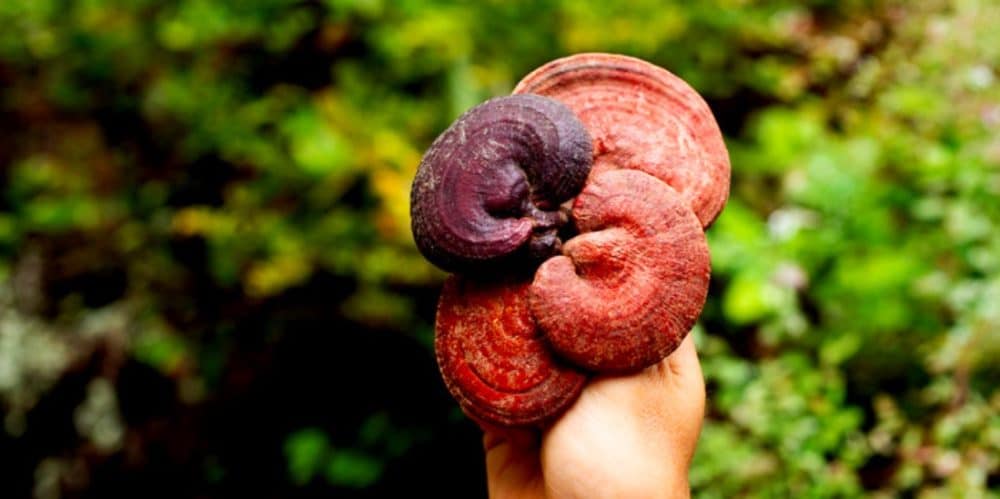
For millennia, reishi mushrooms (Ganoderma lucidum) have been treasured by Eastern medicine practitioners. These powerful fungi boast a host of therapeutic properties and potential health benefits that can be used to support the processes of the immune system. This helps the body’s organs and immune cells adapt to stresses and promote calm and balance.[1]
In China and Korea, reishi mushrooms (Ganoderma lucidum) are known as Lingzhi, which means “herb of spiritual potency,” while in Japan, they are called reishi or mannetake.[1] These mushrooms became revered in Eastern medicine for their innumerable nutritional and health benefits.
The earliest known writing on reishi is found in the Shennong Material Medica (Herbal Pharmacopoeia), credited to Shennong, the god of agriculture.
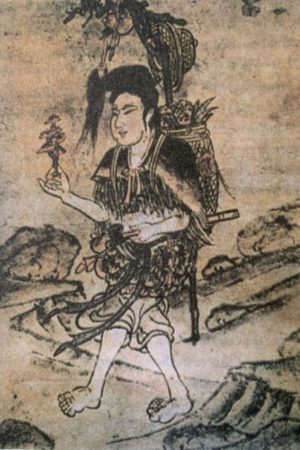
The true author is unknown, but it is believed that Shennong recorded the health benefits of 365 different herbs, then classified them by their health value. In his Material Medica, Shennong classifies the reishi mushroom as one of the most superior medicinal plants of all. This surpasses even ginseng in his rankings on health value and safety.
Reishi mushroom, or the “Mushroom of Immortality” as it’s known in traditional Chinese medicine, was so revered for its impact on health and longevity that it has been heavily depicted in art beginning with the Yuan Dynasty (1280-1386 AD).[1]
Western use of reishi mushrooms for wellness purposes has only recently been adopted, but its popularity continues to grow at a rapid pace as people look for alternatives to allopathic treatments.
An increasing number of peer-reviewed studies show strong evidence supporting the use of Reishi to help the body adapt to a number of stressors. As a result, many people are now eager to incorporate this adaptogenic mushroom into their lifestyles.
In this article, we explore the history of the Reishi and the benefits of adding them to your diet as a supplement. We’ll also look at practical, easy (and delicious) ways to use these fungi in your daily life so you can reap the benefits.
Reishi (Ganoderma lucidum), or Lingzhi, appears in historical texts from China and other Asian cultures dating back over 2,000 years, but they have been in use medicinally for at least 4,000 years. There is also evidence of their use in ancient India during the same time period.[1]
Reishi (Ganoderma lucidum) came to be revered in Chinese culture because of its many benefits.[2] Reishi mushroom side effects are few, so their regular consumption was encouraged by medical practitioners as being safe and effective. [2]
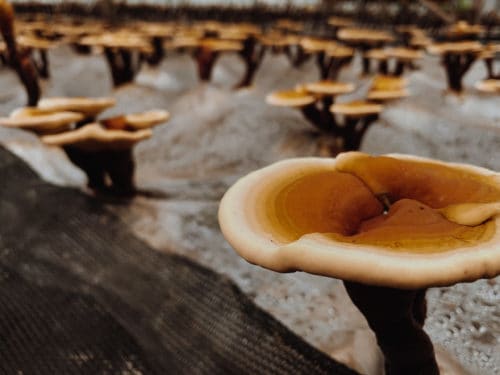
Contributing further to its prized status, the Ganoderma lucidum was typically difficult to find in the wild. Reishi mushrooms were only found growing in certain remote mountainous areas in China, making them difficult to harvest. As a result, there was not enough supply for large-scale medicinal use and application to the general population.[2]
This scarcity, together with its healing properties, made reishi mushrooms (Ganoderma lucidum) highly valued by many Chinese emperors and the wealthy elite. These same wealthy elite were the only ones who could afford its high cost.[4] It wasn’t until the 1970s that certain enterprises began commercially cultivating Reishi in an effort to keep up with increasing demand in both Asia and around the globe.[4]
Over the centuries, reishi mushrooms have been regularly depicted in Chinese art and are associated with Taoism. Reishi (Ganoderma lucidum) was also commonly carried by the wealthy as a talisman to ward off evil spirits and bad omens.
Vividly written descriptions of red reishi mushrooms’ powerful benefits and “immortal” qualities are common in ancient medical texts and religious scripts.
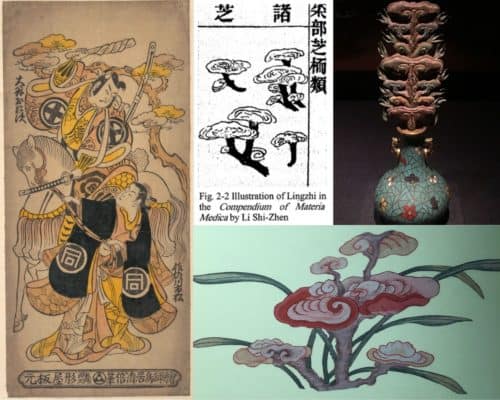
Wang Chong of the Eastern Han Dynasty wrote that “including it [Reishi] in the diet can result in longevity as it is god’s food.”[2] Reishi is also described as the “Medicine of Kings.”[3]
Its ongoing use as a spiritual tool and functional medicinal herb caused it to become widely used in art and cultural practices throughout China. These fungi can be found depicted in books and emblazoned on household decorations, furniture, carpets, jewelry, women’s hair combs, and even perfume bottles.[1]
With reishi mushrooms’ legendary status well established, these trends in Chinese culture and art continue today.
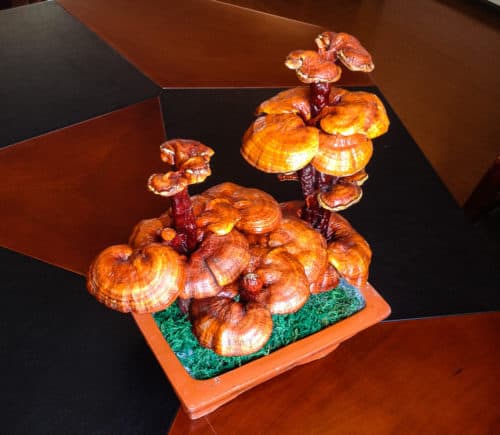 Reishi mushrooms are so revered in China that it is common to find it used as decoration, such as this restaurant table centerpiece. ©Real Mushrooms
Reishi mushrooms are so revered in China that it is common to find it used as decoration, such as this restaurant table centerpiece. ©Real Mushrooms
Taking reishi mushroom can have various effects on the body, from supporting immune function to helping maintain healthy blood sugar and blood pressure levels. This is why many companies are selling reishi mushroom supplements to a wide demographic.
Reishi mushrooms contain over 400 different bioactive compounds, including triterpenoids, polysaccharides, nucleotides, sterols, steroids, fatty acids, proteins, peptides and trace elements.[3] Taking reishi mushroom benefits a lot of people, which is also leading to a rise of the functional mushroom’s accessibility in bulk powder and pill form.
The bioactive compounds in reishi mushrooms work on a cellular level, providing support to bodily systems, such as the immune system, that help them function optimally. Mushroom proteins contain all the essential amino acids your body needs to stay healthy.
The low total fat content and high proportion of polyunsaturated fatty acids are considered significant contributors to reishi mushroom's health value.[4]
The effect of these compounds on the body and specific illnesses has been studied and documented in both Eastern and Western medicine. In the book Lingzhi: From Mystery to Science, mushroom expert Zhi-Bin Lin indicates that modern pharmacological studies show reishi’s effectiveness in treating various conditions.
He suggests that these could possibly relate to the “heart-boosting” and “chest cough relieving” effects recorded in Traditional Chinese Medicine texts.[2]
Further to this, reishi mushrooms are a part of the State Pharmacopoeia of the People’s Republic of China (2000) and it is indicated to “balance Qi, ease the mind and relieve cough and asthma, and [Reishi] is recommended for dizziness, insomnia, palpitation, and shortness of breath.”[4]
While these uses are common and generally safe, it's important to always speak with a healthcare provider before using Reishi mushrooms.
There are over 2,000 different species of reishi mushrooms, but ancient Chinese texts discuss the six colors of reishi. Known as the “6 Zhī (芝)” where “zhī” commonly meant mushroom or fungi.
However, in Daoism "zhī "refers to special plant, animal, or mineral substances said to promote longevity. The most common and well-known color is the red variety which is still known in Chinese as Língzhī (灵芝). The other colors are blue, yellow, black, white and purple.
Each type of reishi mushroom was described to grow near some of the famous mountains in China. Red reishi mushrooms around Mt. Huo, black reishi mushrooms around Mt. Heng, blue reishi mushrooms around Mt. Tai, white reishi mushrooms around Mt. Hua, and yellow reishi mushrooms around Mt. Song.[2] These location markers have long been debunked as reishi mushrooms grow wild all over China and around the world.
The reported health benefits from these six mythical reishi mushroom colors are wide-ranging and worth exploring in more detail.[3]
Since there was no genetic identification thousands of years ago, the existence of many of these species is debated. In the 1990s, Chinese mycologist Zhao Ji-Ding and others classified the “6 Zhī” as described in the Materia Medica. Their results concluded that the “6 Zhi” are not all Lingzhi (or of the Ganoderma species).[5]
So, if these mythical reishi weren’t all true reishi, what species were they?
Red reishi is the best-known of all reishi fungi. The most popular species is Ganoderma lingzhi (or lucidum), in addition to varieties native to North America, like Ganoderma tsugae and Ganoderma oreganese. [6]
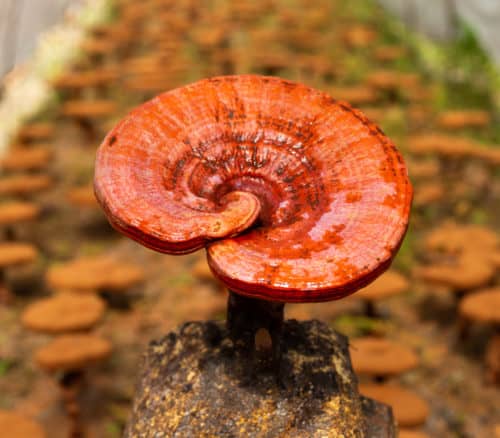
The red reishi mushroom is known to support the healthy function of internal organs like the liver, lungs, and heart. Of all the varieties, the red reishi mushroom is traditionally considered to be superior to other colors because of its high polysaccharide content, such as beta-glucans.[3]
Red reishi mushrooms also have very high antioxidant content and thus supports cellular health and functional inflammatory responses.[11]
The red variety of reishi mushrooms is also the most common. Global demand for red reishi is higher due to its prestige, superior health benefits, and nutritional profile. Commercialized agriculture in China, Japan, and other Asian nations focuses on this fungi because of these key factors.
Due to its superior complex of beneficial, bio-available compounds, red reishi (Ganoderma lingzhi) is the variety we use in our Reishi 415 extract powder.
As you can tell by the name, black reishi mushroom is not a Ganoderma species but it grows in tropical regions and has very similar physical characteristics to Ganoderma. So, it’s not surprising that this was considered to be Reishi.
There are traditional uses of black reishi mushrooms by indigenous communities, and in China they refer to it as “Jiǎzī.”
For example, Indigenous tribes in Malaysia fashion fungal necklaces from the mushrooms (fruiting bodies) for their infants. They say it helps to soothe them in a way similar to amber necklaces popular in the West.
It has a very limited body of scientific research but shows a similar antioxidant capacity to most functional mushrooms.[7] Black reishi mushrooms have been used in interesting folk practices throughout Asia.
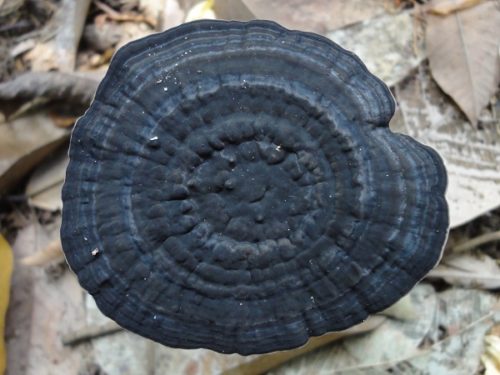
Some speculate that black reishi mushrooms could also have been Polyporus melanopus, which is white when young but gradually turns brown with a brown-to-black stem.
Today, when mentioning black reishi, one would more likely think of Ganoderma sinense.
Not always purple in appearance, purple reishi mushrooms are thought to be Ganoderma sinense or what many would refer to today as black Reishi (Zǐzhī 紫芝). This variety is cultivated in China and is wild-harvested throughout Asia.
Similar in genetic composition to the red Reishi, it is sought after for its more delicate taste and immune-system supporting health benefits.[8] Many Chinese herbalists will carry these fungi as they are known for supporting healthy lung function.
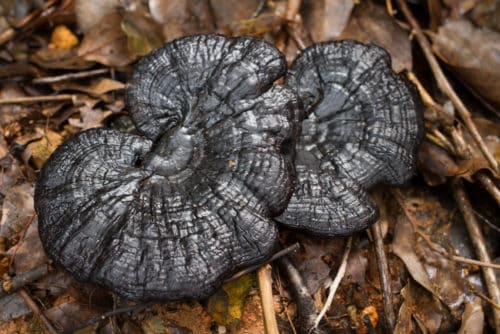
In 2010, Ganoderma sinense tablets were approved by the Chinese State Food and Drug Administration as a relief for the side effects of chemotherapy.[10]
Many mushroom foragers will know that Laetiporus sulphureus, a.k.a “chicken of the woods,” is not a Ganoderma species, but it sure looks like it. Chicken of the woods is primarily native to Europe and North America, not Asia, and is a bracket fungus with a similar appearance to Reishi.
The lighter color and younger growth areas are commonly eaten and reported to taste like chicken, hence its name. This species can grow up to 100 pounds.
Though chicken of the woods does have some research and will contain similar compounds to other polypores like reishi mushrooms, it is not typically known as a functional mushroom.
Today, Ganoderma curtisii is known as yellow reishi. Ganoderma curtisii is native to North America and typically found along the eastern US coast growing on decaying stumps and roots. However, yellow reishi mushrooms grow well in temperate climates and have been found as far south as Mexico. With a biochemical profile very similar to red reishi, it has many of the same health-promoting benefits as the more common red variety.
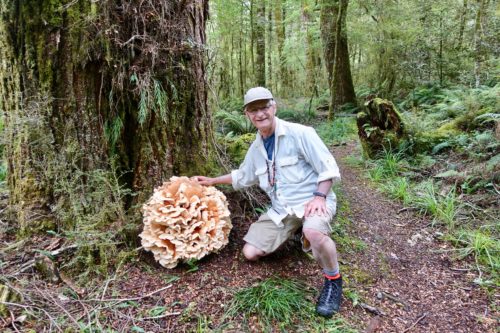
Blue reishi, or sometimes called green reishi, is more well-known as turkey tail (Trametes versicolor) or Yunzhi (雲芝) in Chinese. As you can see, this is not a Ganoderma species but has similar visual characteristics.
The multi-colored pattern on turkey tail mushrooms is described as looking like the feathers of a peacock. This miracle mushroom grows all over the world and is one of the most popular functional mushrooms.
Turkey tail is very well known in Asia since two effective cancer-fighting drugs have been developed from it: Polysaccharide K (PSK) in Japan and Polysaccharide Peptide (PSP) in China. It is also loaded with prebiotics, which help maintain a healthy gut balance and help reduce indigestion.
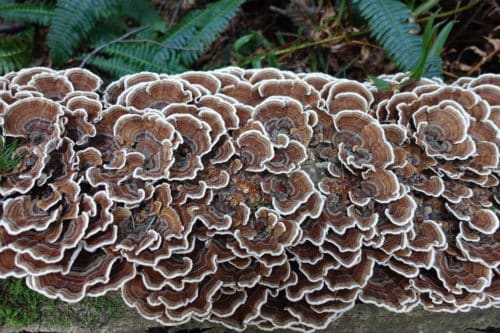 Turkey tail (Trametes versicolor) growing in the wild on a dead log in the Pacific Northwest. ©Real Mushrooms
Turkey tail (Trametes versicolor) growing in the wild on a dead log in the Pacific Northwest. ©Real Mushrooms
Turkey tail benefits aren’t just for humans either. Veterinarians have found that Turkey Tail supplements can help promote healthy cellular responses in cats and dogs suffering from malignant cell growth.
The beta-glucans in Turkey Tail mushrooms also help to balance the immune responses in dogs with auto-immune disorders.[8] When considering your pet’s health, don’t overlook the potential of these powerful fungi.
More commonly known as Agarikon, white reishi’s uses for health and wellness can be traced as far back as Ancient Greece where it was used as a treatment for tuberculosis and smallpox. The Greek physician Dioscorides even nicknamed it “elixirum ad longam vitam”, or the elixir of long life.
Today, Agarikon is most commonly found in old-growth forests in the Pacific Northwest. This has led to it being extremely rare, resulting in limited research on the specific use cases and best practices for application. Despite this scarcity, recent studies have shown white reishi mushrooms to possess antimicrobial properties.[9]
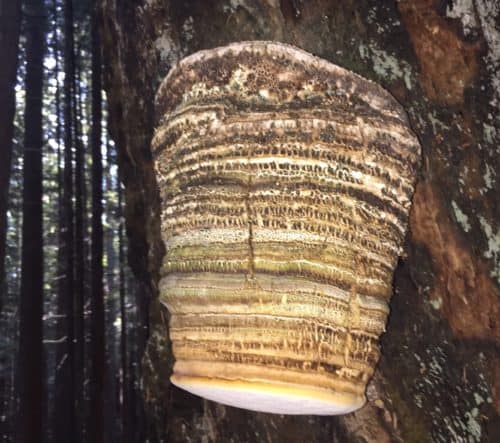
Additional research into its powerful and numerous benefits is only just getting started. However, deforestation is leading to fewer and fewer areas for this fungi to grow naturally, and growers have had difficulty cultivating it in artificial settings.
It is important to remember that when these different species of fungi were named Reishi, there were no species identification methods in place other than physical characteristics (does it look like a Reishi?). As we can see, only 2 of the 6 colors are true Reishi. However, the majority of these species are polypore fungi and look quite similar, so it's not surprising that thousands of years ago, they were classified together.
Reishi mushrooms may be difficult to add to your diet since they are hard, dense polypores, so you might not necessarily eat them as is. However, once it is processed into a powdered extract, it can be used in recipes or taken in capsule format. This is why taking reishi mushroom supplements is gaining more popularity.
Reishi is known for having a bitter taste which comes from its beneficial triterpenes. This bitterness is also a quality indicator. If you find yourself using a Reishi powder that does not have a strong bitter flavor, you know you have a supplement with inferior potency (or one without authentic Reishi in it at all).
On our website, we feature a collection of whole-foods-based recipes that incorporate reishi supplements into everything from your morning coffee to smoothie bowls and desserts.
Take a look at our Reishi Bounty Bars or Medicinal Chocolate Bark to satisfy your sweet tooth. Both recipes incorporate our Reishi 415 powder to give these treats an extra health-boosting kick.
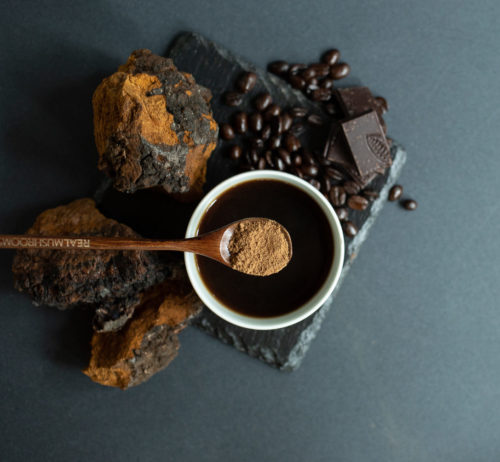
Reishi mushroom tea is a popular alternative to coffee and can be made easily by mixing powdered reishi mushroom extract into your favorite brewed tea, or by purchasing the tea separately.
We’ve also put together two Vegan Golden Milk recipes. These recipes take advantage of the calming effects of Reishi and the cognitive health benefits of Lion’s Mane mushrooms to help you improve your sleep and reduce your reliance on stimulants to get you moving in the morning.
As with all dietary supplements, you should discuss their use with your healthcare provider before starting any new protocol with reishi supplements. It’s important to determine if there is a risk of any side effects or interactions with other medications you’re taking.
In general, Reishi is a very safe plant with few side effects or risks. However, if you are taking anticoagulants, antiplatelet drugs, or high blood pressure medication — or if you are pregnant or breastfeeding — be sure to talk to your doctor before supplementing with reishi supplements.
Visit our website to learn more about our line of high-quality, real mushroom extract supplements and the many health benefits these functional mushrooms have. We offer 100% organic reishi extract products produced from our organically grown red reishi in both powder and capsule form, so you can find what works best for you.
Disclaimer: The information or products mentioned in this article are provided as information resources only, and are not to be used or relied on to diagnose, treat, cure, or prevent any disease. This information does not create any patient-doctor relationship, and should not be used as a substitute for professional diagnosis and treatment. The information is intended for health care professionals only. The statements made in this article have not been evaluated by the Food and Drug Administration. Any products mentioned are not intended to diagnose, treat, cure, or prevent any disease. The information in this article is intended for educational purposes. The information is not intended to replace medical advice offered by licensed medical physicians. Please consult your doctor or health practitioner for any medical advice.